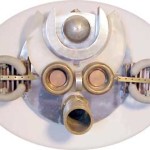A mytho-historical novel about the Manhattan Project, our sense of place, the natural world, the beginnings of the military industrial complex, how we think about cause and effect, and what it means to be a modern woman.
ISOTOPIA/K’AÁW is inspired by the life of the only woman physicist to work on the Manhattan Project and the lifeways and culture of the Wanapum people. This novel pivots upon one stretch of Chiawana-the Columbia River-a place where fuel for the first atomic bomb was created, a sacred place of sustenance and relation.
Most accounts of the Manhattan Project at Hanford (Washington) have focused upon its creation of the world’s first full-scale plutonium production reactor, the displacement of farmers in White Bluffs, the build-out within the TriCities, and/or the Project’s legacy of toxicity.
Few have considered that Hanford was sited on Wanapum homelands. I have the ongoing privilege of working with Wanapum people as I have written and revise this manuscript.
This novel is based in part upon The Uranium People, the autobiography of Leona Woods Marshall Libby, the only woman physicist on the Manhattan Project, and upon many Manhattan project records, scientific and military.

We follow Leona Wilds as she is hired by the Manhattan Project and carefully navigates her relationships with older male scientists so she can work on the Project as it moves to Hanford (Washington), and then to Los Alamos, where she witnesses the detonation of the world’s first atom explosion. Bombs she helped create devastate Hiroshima and Nagasaki, WWII ends, and the Project’s scientific community is in disarray. When her husband dies from radiation poisoning Leona is fired from what is left of the Project. She begins to question science itself, and returns to Hanford, realizing her career has been shaped as much by her choice of lovers as her scientific acumen.
As soon as she arrives at post-war Hanford, she realizes she never knew the place, only the insular world of its reactors and scientists. She flees Hanford Engineering Works, unsure of everything. An accident leaves her unconscious. Beverly Dawson, a Wanapum woman worn down by age and isolation, finds her. With her two sisters, she begrudgingly takes Leona into their home and a world she has barely seen and never registered.
The end of the war did not bring much change to the sisters’ disrupted lives, still barred from their homelands and related lifeways. As Beverly, Doris, and Smyrna nurse and badger Leona and bicker amongst themselves, she begins to recall who she is and some of what she has done. She hides from herself and avoids their questions until an event by the Columbia River forces her to reconcile her scientific and intellectual training with her physical experiences and the sanctity of nature.
Washed to shore, she begins to walk along Chiawana, the Columbia, unsure what conflated recombinant version of herself she has become, beginning her new life, step by step.
Beverly, sitting near Chiawana, does not know if Leona is alive or dead, nor whether the Wanapum will return to their homelands. She does know the river perseveres.
******
